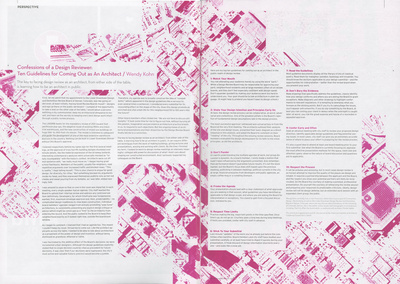
Confessions of a Design Reviewer:
Ten Guidelines for Coming Out as an Architect
Author Wendy Kohn
Arcade 26.03 (2008): pp. 8-9
Excerpted as “The Civic Design Review Process” for AIA Best Practices
The key to facing design review as an architect, from either side of the table, is learning how to be an architect in public.
First, let me admit that my appointment to the Lower Downtown Design and Demolition Review Board of Denver, Colorado was, at least initially, like going undercover. Having faced Review Boards myself – designs and ego up there on the dartboard of public review – I jumped at the opportunity to take a seat on the other side of the table. I would adopt a persona befitting a city commissioner, keep my architectural allegiance to myself, and learn all the secrets to keeping one’s best design work intact through a public review process.
ADOPT A “PUBLIC” PERSONA
The key to facing design review as an architect begins with context: recognize you’ll need different techniques from those you use regularly to make buildings, to give architectural lectures and presentations, or to woo and work with clients. Although the design review process may at times seem political and repetitive, it can also include intensely meaningful, collegial, and powerful discussions about shaping our built environment.
Here are my top 10 guidelines for effective presentations in a public review process.
1. Watch your mouth.
You risk alienating your audience merely by using the word “parti.” While a design review board may be responsible for approving your parti, neighborhood residents and at-large members who serve on review boards often don’t feel especially confident with design-speak. Don’t waste goodwill by making your audience work too hard to understand you. Your goal should be to talk about architecture in plain language. .
2. State your design intention and principles early on.
At best, the design review process can be collaborative; at worst, adversarial and contentious. One of the greatest pitfalls is the board’s rejection of fundamental design assumptions late in the design process. The most successful approval I witnessed won universal buy-in from the board at the first meeting. The architects outlined their analysis of the site and design issues, presented their basic diagram as a direct response to this analysis, and asked the board to comment on their “reading” of the city. Throughout the ensuing review sessions, board members evaluated the design development for its faith to the initial principles—as did the architects.
3. Don’t pander.
It’s worth recognizing that individual board members often approach decisions with biases, prejudices and agendas. Yet, as a board member, I rarely made a motion that wasn’t influenced by the discussion at hand. And remember: Past performance doesn’t guarantee future results. It’s not the stock market, but the board’s focus can shift based upon political currents in the city at large, financial issues raised by developers and public agencies, or dissatisfaction with the built results of previous decisions.
4. Frame the agenda.
Your presentation should lead with a clear statement of what approvals you are seeking in that session, what guidelines you have identified as applicable to that design scope, and where you are asking the board for interpretation or exceptions. You stand to gain from a focused discussion, initiated by you.
5. Respect time limits.
Practice making the big, important points in the time specified. Once time’s up, do not go on. Courtesy goes a long way during long meetings. If time limits are unstated, confer with city staff in advance.
6. Stick to your submittal.
Last-minute “updates” of the work you’ve already put before the committee often backfire. Board members and city staff have studied your submittal carefully, or at least have tried to digest it quickly during your presentation. A freak blizzard of design information disorients everyone—and looks like a cover-up.
7. Read the guidelines.
Most guideline documents display all the literary tricks of classical poetry. Read them for metaphor, paradox, tautology, and innuendo. You should know the sections applicable to your design submittal—and the opportunities for interpretation—better than the review board when you present your work.
8. Don’t bury the evidence.
Make drawings that specifically address the guidelines, and clearly identify how your design conforms and where you are asking the board to grant exceptions. Make diagrams and other drawings to highlight conformance to relevant regulations. It is tempting to downplay what you foresee as the sticking points, but if you try to camouflage the issues, you’ll appear untrustworthy. If you do slip something by the board, at best you risk costing your client in delays when the oversight is caught later; at worst, you risk the great expense and hassle of a rescinded or appealed approval.
9. Confer early and often.
Seek an advance meeting with city staff to review your proposed design direction, identify applicable design guidelines, and flag potential zoning issues. In most cases, city staff can give you an extremely accurate sense of where to place your effort in preparing for the review process. It’s also a good idea to attend at least one board meeting prior to your first submittal. See what the board is currently focusing on; appraise the most effective presentation methods for the space, room size, and attention spans; observe the nature of board discussion and questions put to applicants.
10. Respect the process.
It can be arduous and annoying, but in most cases design review is an honest attempt to improve the quality of the places we design and inhabit. It requires a partnership between the applicant and the board, and the respect you show your potential partners will likely be reciprocated. Do the board the courtesy of making a polished, professional presentation. Do yourself the courtesy of rehearsing the review session and preparing your responses to predictable criticisms. Ideally, design review will not be design defense but, rather, an extended work session with an expanded client group: the public.□

